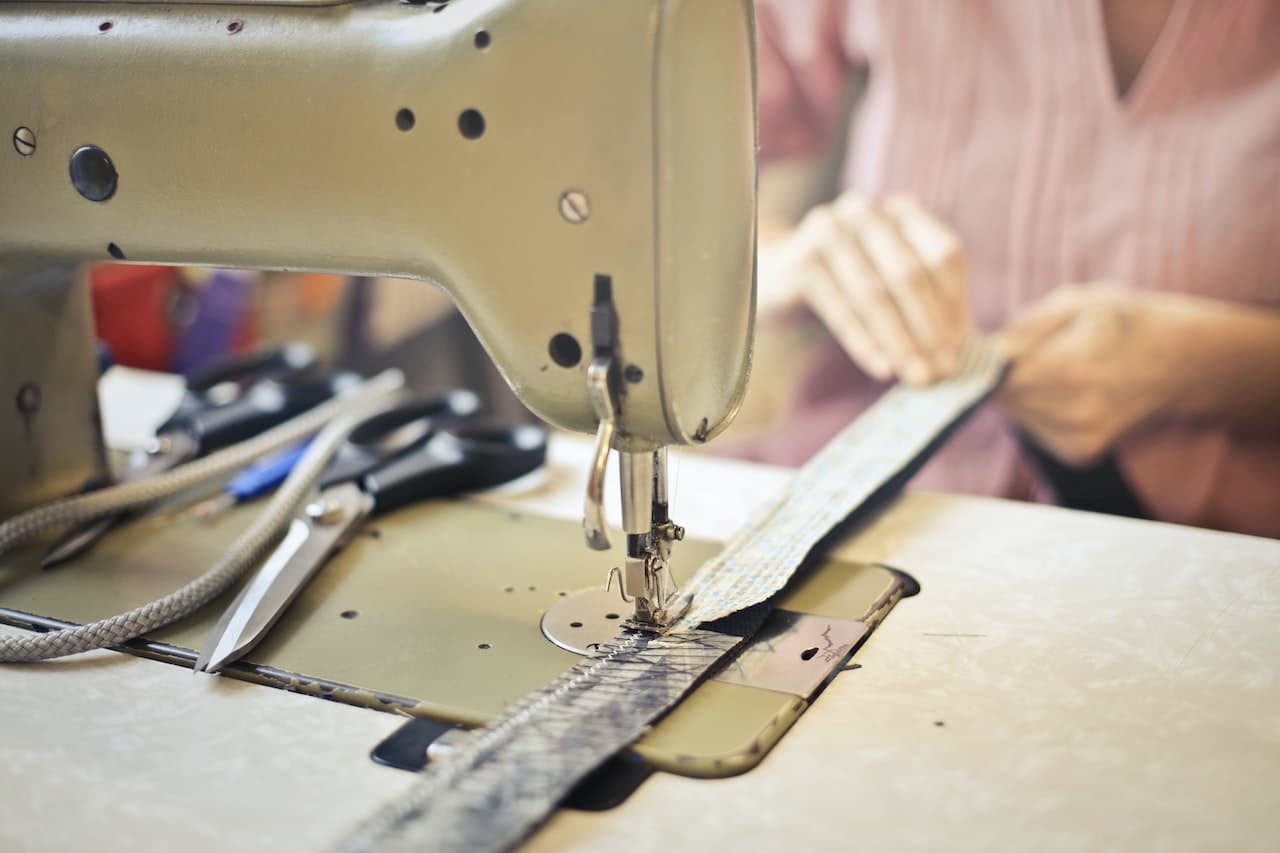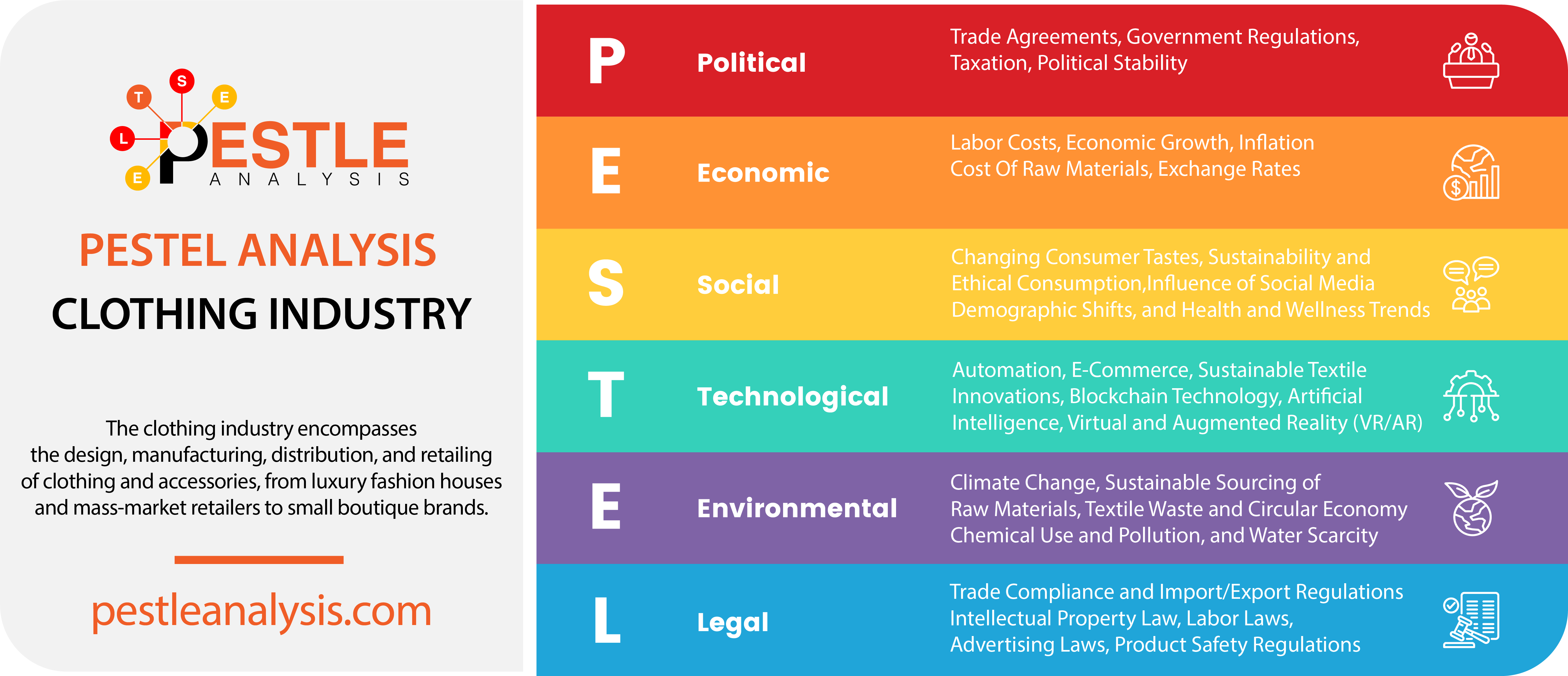Do you follow the latest fashion styles introduced by top clothing brands such as Gucci, Prada, and Versace? If yes, then you must read this article since it provides insight into the clothing industry and discusses the external factors that impact it.
The clothing industry is one of the biggest industries across the globe since every human on this planet requires clothes to wear. Regardless of ethnicity, class, and any other division, people living in every part of the world are involved in the clothing industry in one way or another.
Looking at the significance of the clothing industry, today we have decided to conduct a PESTLE Analysis of The Clothing Industry. However, before conducting the PESTLE analysis, let's discuss the history of the clothing industry.
Clothing Industry's History & Overview
The clothing industry, also known as the fashion industry, has a fascinating history dating back to the early civilizations of ancient Egypt, Greece, and Rome.
Clothing has always been an essential aspect of human culture, providing protection, comfort, and a means of self-expression. In the early days, clothing was primarily made by hand, with skilled artisans using natural fibers such as wool, cotton, and silk to create functional and beautiful garments.
During the industrial revolution, the clothing industry began to change dramatically. New technologies paved the way for the mass production of clothing, making it more affordable and accessible to the general public.
In the early 20th century, fashion designers emerged as celebrities, and fashion shows became a way to showcase new designs. In addition, the 1920s and 1930s were marked by the emergence of haute couture. This term refers to high-end, custom-made clothing often worn by celebrities and socialites.
In the 1950s, the rise of television and the movie industry helped to popularize fashion, with stars like Marilyn Monroe and Audrey Hepburn becoming style icons.
The 1960s and 1970s were marked by a significant cultural shift towards individual expression, leading to the popularity of ready-to-wear fashion and the emergence of fashion icons such as Twiggy and Jacqueline Kennedy Onassis.
The 1980s and 1990s saw an increase in designer brands such as Tommy Hilfiger, Ralph Lauren, and Calvin Klein and the emergence of streetwear as a major fashion trend.
Today, the clothing industry is a multi-billion dollar global enterprise driven by fast fashion and the constant need for new styles and trends.
Fast fashion refers to the production of inexpensive, trendy clothing designed to be worn for a short period and then discarded. Major players in the industry include H&M, Zara, and Nike, among others.
Currently, the clothing industry is one of the biggest industries in terms of revenue. In 2020, the global clothing market was worth $1.590 trillion. The industry is expected to grow at a rate of 4.3% and reach $2.230 trillion by 2028.
Now that we have discussed the history and current position of the clothing industry in detail let's discuss what PESTLE analysis is.
Now that you know what PESTLE analysis is, let's proceed further and conduct a clothing industry PESTLE analysis.
Clothing Industry's Political Factors

The clothing industry is a highly competitive and ever-changing market constantly affected by various political factors.
- Trade agreements: Bilateral and multilateral trade agreements between countries can significantly impact the clothing industry. After all, globalization enables manufacturers to source raw materials and sell products worldwide. These agreements can lower or eliminate tariffs, making it easier for manufacturers to export and import clothing products. However, changes or the dissolution of these agreements can disrupt supply chains and increase costs.
- Government regulations: Product safety and labeling laws, environmental regulations, and anti-dumping laws impact clothing manufacturers and retailers. Strict regulations on the use of chemicals in clothing production can increase manufacturing costs.
- Taxation: Taxation policies affect both consumers and businesses in the clothing industry. Taxes on imported clothing products can increase costs for consumers.
- Political stability: The political stability of a country where clothing is produced can directly impact the industry. Political instability, such as conflicts, strikes, or changes in government, can disrupt supply chains, delay production, and increase costs. Businesses must carefully consider the political climate in regions where they source materials or manufacture products.
Clothing Industry's Economic Factors

The clothing industry is one of the world's largest industries, generating significant revenues and providing employment to millions. The industry is susceptible to various economic factors.
- Labor costs: Labor costs are a significant economic factor in the clothing industry, as the sector relies heavily on human labor for manufacturing and production. Variations in labor costs across different regions influence where companies choose to produce their clothing. Rising labor costs in traditional manufacturing hubs can lead to shifts in production to countries with lower wages, affecting the overall cost structure and pricing of clothing products.
- Economic growth: Economic growth is a significant driver of consumer spending, influencing demand for clothing products. During periods of economic growth, consumers typically have more income to spend on non-essential items like clothing. This increases demand for clothing products, resulting in higher sales volumes and revenues for manufacturers and retailers.
- Inflation: Inflation measures the rate at which prices for goods and services are increasing. High inflation raises the cost of production for clothing manufacturers due to higher prices for raw materials and other inputs. This leads to higher prices for clothing products, which can reduce demand and sales volumes.
- Cost of raw materials: The cost of raw materials, such as cotton, wool, synthetic fibers, and dyes, plays a critical role in determining the overall cost of clothing production. Fluctuations in raw material prices, driven by factors like supply shortages, geopolitical tensions, or changes in agricultural output, can directly impact the profitability of clothing manufacturers. Rising raw material costs may lead to higher retail prices, potentially reducing consumer demand.
- Exchange rates: Exchange rates refer to the value of one currency relative to another. Clothing manufacturers that source raw materials from overseas or sell products in international markets are impacted by exchange rate fluctuations. A decrease in the value of the domestic currency relative to other currencies can result in higher revenues for manufacturers selling products internationally, as their products become more affordable for foreign consumers.
Clothing Industry's Social Factors

The clothing industry is influenced by economic and social factors such as changing consumer tastes, lifestyle trends, cultural values, and demographic shifts.
- Changing consumer tastes: One of the most significant social factors impacting the clothing industry is changing consumer tastes. Consumers’ preferences for clothing styles, colors, and designs constantly evolve, influenced by fashion trends and cultural influences. Clothing manufacturers and retailers that fail to keep up with these changes risk losing market share and profitability.
- Sustainability and ethical consumption: Growing awareness of environmental and ethical issues has led to a significant shift in consumer behavior. Many consumers now prioritize sustainability and ethical practices when purchasing clothing. They seek out brands that use eco-friendly materials, promote fair labor practices, and minimize their environmental impact. Brands that fail to address these concerns risk losing customers who are increasingly focused on responsible consumption.
- Cultural values: Cultural values are another important social factor. Clothing styles and designs that are popular in one culture may not be appropriate in another. Clothing manufacturers and retailers must consider cultural values when designing and marketing their products to ensure they resonate with the target audience.
- Influence of social media and influencers: Social media platforms have become powerful tools in shaping fashion trends and consumer behavior. Influencers, celebrities, and fashion bloggers have a substantial impact on what consumers perceive as desirable. Clothing brands that effectively leverage social media marketing and collaborate with popular influencers can gain a competitive edge, while those that do not may struggle to reach and engage with their target audience.
- Demographic shifts: Demographic changes, such as aging populations or shifts in income levels, can significantly impact the types of clothing products that consumers demand. For example, an aging population may increase the demand for comfortable and functional clothing styles, while shifts in income levels could lead to a change in demand for luxury clothing brands.
- Health and wellness trends: The growing emphasis on health and wellness is influencing fashion choices, with consumers increasingly seeking clothing that supports an active lifestyle. This trend has led to a rise in demand for athleisure wear, which combines style with functionality. Brands that tap into the health and wellness trend by offering comfortable, versatile, and performance-oriented clothing are well-positioned to capitalize on this growing market segment.
Clothing Industry's Technological Factors

The clothing industry has seen significant technological advancements in recent years, which have impacted the production, distribution, and marketing of clothing products.
Technological factors such as automation, e-commerce, and 3D printing have revolutionised clothing manufacturers and retailers' operations.
- Sustainable textile innovations: Technological advancements in textile production have led to the development of sustainable and eco-friendly materials. Innovations such as biodegradable fabrics, recycled fibers, and waterless dyeing techniques are becoming increasingly important as consumers and regulators demand more environmentally responsible products. These advancements allow clothing manufacturers to reduce their environmental footprint while appealing to eco-conscious consumers.
- Automation: Automation is one of the most significant technological factors impacting the clothing industry. It has increased efficiency and productivity in manufacturing, as machines can perform tasks such as cutting, sewing, and stitching much faster than humans. This has reduced production costs and increased the speed of manufacturing clothing products.
- 3D printing: 3D printing technology is beginning to impact the clothing industry. It allows manufacturers to produce products with incredible speed, efficiency, and greater design flexibility. This technology enables the creation of unique, custom-made clothing products tailored to individual customer preferences.
- Blockchain technology: Blockchain is beginning to impact the clothing industry by enhancing transparency and traceability across the supply chain. This technology allows brands to verify the authenticity of materials, ensure ethical sourcing, and provide consumers with detailed information about the origins and journey of their clothing items. Blockchain can help build consumer trust and reduce issues related to counterfeiting and unethical practices.
- Artificial intelligence (AI): AI is also impacting the clothing industry. It can analyze consumer data and identify trends in clothing preferences, helping manufacturers and retailers produce clothing products more likely to be in demand. AI is also used to optimize supply chain management, improving efficiency and reducing costs.
- Virtual and augmented reality (VR/AR): VR and AR technologies are transforming the shopping experience in the clothing industry. Virtual fitting rooms allow consumers to “try on” clothes online, reducing the need for physical store visits and decreasing return rates. AR can also enhance in-store experiences by allowing customers to visualize how clothing items would look on them or how they would pair with other items. Brands that adopt these technologies can offer more personalized and engaging shopping experiences, potentially increasing customer satisfaction and sales.
Clothing Industry's Legal Factors

The clothing industry is subject to various legal factors that impact how clothing products are produced, distributed, and sold.
- Trade compliance and import/export regulations: The clothing industry is heavily impacted by international trade laws and regulations. Compliance with import and export regulations, such as customs duties, tariffs, and trade sanctions, is crucial for clothing manufacturers and retailers. Non-compliance can lead to fines, delays in product delivery, and disruptions in the supply chain. Additionally, companies must navigate complex trade agreements and policies to optimize their global operations.
- Intellectual property law: Intellectual property law is one of the most significant legal factors in the clothing industry. It protects clothing designs, logos, and brand names from being copied or imitated by other businesses. Manufacturers and retailers must ensure their products do not infringe upon others’ intellectual property rights to avoid legal action and potential damage to their reputation.
- Labor laws: Labor laws are another critical legal factor impacting the clothing industry. Manufacturers and retailers must comply with regulations regarding wages, hours, and working conditions. Additionally, they must avoid exploitative labor practices, such as child labor or forced labor. Failure to comply with labor laws can lead to legal action and reputational damage.
- Advertising and marketing laws: Clothing companies must ensure that their advertising and marketing practices comply with legal standards, including truth in advertising, transparency, and avoiding misleading claims. This is particularly important when it comes to promoting sustainability, ethical practices, or product safety. Misleading advertisements can lead to legal action, fines, and a loss of consumer trust, which can have long-term negative effects on the brand.
- Product safety regulations: Product safety regulations are a significant legal factor in the clothing industry. Clothing products must comply with safety regulations to protect consumers from harm. Manufacturers and retailers must ensure their products do not contain harmful chemicals or materials and are properly labeled with care instructions and warnings.
- Data protection and privacy laws: As the clothing industry increasingly relies on e-commerce and digital marketing, compliance with data protection and privacy laws has become critical. Laws such as the General Data Protection Regulation (GDPR) in Europe and the California Consumer Privacy Act (CCPA) in the United States require companies to handle customer data responsibly, ensuring that personal information is collected, stored, and used in a secure and transparent manner. Non-compliance can result in hefty fines and damage to the brand’s reputation.
- Consumer rights and protection laws: Clothing companies must adhere to laws that protect consumer rights, including those related to returns, refunds, and warranties. Regulations may vary by region, but they generally ensure that consumers can return or exchange defective products, receive refunds, and be informed of their rights. Companies that fail to comply with these laws may face legal action, fines, and a loss of consumer trust.
Clothing Industry's Environmental Factors

Environmental factors such as climate change, water scarcity, and waste management have become increasingly important. As a result, they are now major considerations for businesses operating in the clothing industry.
- Climate change: Climate change is a key environmental factor impacting the clothing industry. Clothing production requires significant energy, primarily from fossil fuels, and the production of synthetic fibers like nylon and polyester generates greenhouse gas emissions. Clothing businesses must reduce their carbon footprint by adopting sustainable practices, such as using renewable energy and reducing waste.
- Sustainable sourcing of raw materials: The sourcing of raw materials, such as cotton, wool, and synthetic fibers, has significant environmental implications. The cultivation and extraction of these materials can lead to deforestation, loss of biodiversity, and soil degradation. To mitigate these impacts, clothing businesses are increasingly focusing on sustainable sourcing practices, such as using organic cotton, recycled materials, and responsibly sourced wool. Ensuring the traceability of materials and working with suppliers that adhere to environmental standards are critical steps in reducing the industry’s environmental footprint.
- Textile waste and circular economy: The clothing industry generates vast amounts of textile waste, both during the production process and through consumer disposal of unwanted garments. This waste often ends up in landfills, contributing to environmental degradation. To address this issue, the industry is increasingly embracing the principles of the circular economy, which focuses on designing products for longevity, promoting garment recycling, and encouraging consumers to repair, reuse, or recycle clothing. Implementing take-back programs, using biodegradable materials, and creating clothing with modular designs that can be easily disassembled and recycled are strategies that can help reduce textile waste.
- Chemical use and pollution: The use of chemicals in textile production, including dyes, finishes, and treatments, can have harmful environmental effects if not managed properly. The discharge of untreated or poorly treated wastewater from factories can lead to water pollution, harming aquatic ecosystems and contaminating drinking water sources. Clothing companies must adopt safer chemical management practices, including the use of eco-friendly dyes, reducing hazardous substances, and ensuring proper wastewater treatment, to minimize their environmental impact.
- Water scarcity: Water scarcity is a significant environmental factor in the clothing industry. Cotton production, widely used in clothing, requires large amounts of water. Additionally, dyeing and finishing textiles require significant water resources. This can lead to water scarcity in areas with limited resources, making it crucial for clothing businesses to adopt water-efficient practices.
Recommendations on our PESTLE Analysis of The Clothing Industry

The clothing industry is one of the most significant industries operating globally. This article discussed the history of the clothing industry and shed light on how it evolved over the years.
Moreover, it also discussed the current status of the clothing industry.
After providing insight into the clothing industry, we conducted a PESTLE analysis to see what external factors impact the clothing industry.
The PESTLE analysis helped us in analyzing how various political, economic, social, environmental, technological, and legal factors impact the clothing industry.
After reading this article, we assume you know what external factors impact the clothing industry. Moreover, reading this article would also have made you aware of the PESTLE analysis framework.
If you want to read more PESTLE analysis articles, do look at some of the PESTLE analysis examples.






